Connecticut Magazine (Neag School alum Alison Burdick ’00 (ED), ’01 MA, ’15 Ed.D. named to 2017’s “40 Under 40”)
5 Ways Schools Can Positively and Proactively Support All Students
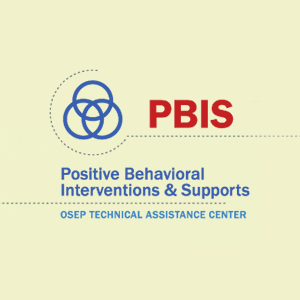 Editor’s Note: The following PBIS Practitioners Guide[1] — titled “Addressing School Climate: 5 Ways Schools Can Positively and Proactively Support All Students”[2],[3] — originally appeared on the OSEP Center on Positive Behavioral Interventions and Supports website and is authored by the following faculty members in the Center for Behavioral Education and Research at the Neag School: Brandi Simonsen, George Sugai, Jennifer Freeman, and Tamika La Salle. To access this and other resources related to positive behavioral interventions and supports, please visit pbis.org/whats-new.
Editor’s Note: The following PBIS Practitioners Guide[1] — titled “Addressing School Climate: 5 Ways Schools Can Positively and Proactively Support All Students”[2],[3] — originally appeared on the OSEP Center on Positive Behavioral Interventions and Supports website and is authored by the following faculty members in the Center for Behavioral Education and Research at the Neag School: Brandi Simonsen, George Sugai, Jennifer Freeman, and Tamika La Salle. To access this and other resources related to positive behavioral interventions and supports, please visit pbis.org/whats-new.
School Climate Challenges
Bullying incidents and other concerning behaviors present educators with significant, immediate challenges in supporting students. Rather than waiting for these behaviors to occur and reacting, we encourage educators to adopt positive and proactive practices to support students and prevent these behaviors from occurring.
Three Reasons to Invest NOW in Positive and Proactive Practices
- Schools often serve as the de-facto mental health support system for students. Providing all students with a safe, predictable, and positive environment is critical in effectively addressing many mental health concerns.
- Implementing basic positive and proactive practices works. When these key practices are implemented well, students’ social, emotional, behavioral, and academic outcomes improve.
- By implementing positive, proactive practices, schools can more effectively support students who may experience greater difficulties and require additional support.
A Call for Positive and Proactive Practices
School leaders and educators must not wait until students demonstrate signs of stress or report bullying incidents. We must act now and proactively address students’ social, emotional, and behavioral needs; bolster positive school climates so that learning can occur; and firm up our relationships with students to ensure they feel safe, appreciated, and respected.
Specifically, educators must increase their investment in and use of five empirically supported, high-impact practices:
- Establish positively stated expectations that explicitly communicate respect for all students and that value and embrace diversity among students as well as adults. Clearly describe how students and adults can display observable expectations in each classroom routine and school setting that contribute to a common language and a predictable, respectful, and safe experience for all.
- Explicitly and purposefully teach expectations across all classroom routines and school settings. Specifically define, model, and practice each expectation, and use positive and negative examples so that students see the line between appropriate and inappropriate behavior and actions. Also, teach students specific problem-solving strategies for instances in which they experience or see disrespectful behavior. Create a school-wide “stop signal” for disrespect. Teach students to use that signal to walk away from disrespectful acts. Show students how to use that signal when standing with a peer who is experiencing disrespectful behavior. And, help students identify how and when they should report disrespectful actions to an adult.
If simple instruction is not sufficient, adopt a structured social skills program. For example, Bully Prevention is a free, empirically supported curriculum that may be used to supplement school-specific lessons. The Collaborative for Academic, Social, and Emotional Learning is a useful guide to other curricula. Consider explicitly teaching expectations in the context of the national dialogue through practice and mini-lessons on how to interact respectfully with others who supported different political positions.
School leaders and educators must not wait until students demonstrate signs of stress or report bullying incidents. We must act now and proactively address students’ social, emotional, and behavioral needs
- Give specific praise for displays of appropriate behavior. Actively supervise students to catch as many instances of appropriate behavior as possible. When disrespectful behavior occurs, provide a specific error correction to identify the mistake and to teach and practice the correct response. Give feedback so that praise exceeds corrections (e.g., 4 to 1 ratio).
- Use data to monitor implementation, and screen for students who require more intensive support. Monitor how lessons are provided and how students respond to the behavior of their peers. Although published screening and progress monitoring tools are available, start regularly examining existing data sources (e.g., office referrals, school nurse visits, academic failure, attendance) to identify students who may require more targeted or intensive supports. Look for students who display interpersonal (e.g., teasing, intimidation, harassment) as well as personal (e.g., withdrawal, anxiety, self-harm) challenges.
Utilize school climate data to examine experiences of groups of students who may be more personally affected by the national conversation, including students who identify as Muslim, Jewish, Black, Latinx, or LGBTQ; have disabilities, history of trauma, or mental health challenges; have recently immigrated to the United States or have family members who are immigrants; or represent other diverse backgrounds. Diversity is a positive quality; embracing and valuing diversity requires a safe, respectful environment and a deliberate approach that supports all students, families, and staff members.
- Provide a differentiated continuum of positive support for students that integrates and addresses academic, behavioral, social, and emotional needs and expectations within a multi-tiered systems of support (MTSS) framework, such as Positive Behavior Interventions and Supports or Response to Intervention. Work as teams within MTSS to identify and deliver appropriate practices for students who require targeted or intensive support. Use student responsiveness to intervention to move to more or less specialized supports.
Schools and/or classrooms that use these five practices on an ongoing basis tend to have positive climates and the capacity to be proactive in addressing the social, emotional, and behavioral needs of their students.
[1] The purpose of “PBIS Practitioner’s Guides” is to suggest PBIS-based strategies for educators in classrooms and schools, especially, in the context of contemporary priorities, initiatives, and concerns. Technical Guides are usually available to provide the theoretical, conceptual, and/or empirical background and support.
[2] The development and preparation of this PBIS Practitioner’s Guide was supported in part by a grant from the Office of Special Education Programs, U.S. Department of Education (H029D40055) and by the Center for Behavioral Education and Research in the Neag School of Education at the University of Connecticut. Opinions expressed herein are the author’s and do not reflect necessarily the position of the US Department of Education or University of Connecticut, and such endorsements should not be inferred. Contact: Brandi Simonsen (Brandi.simonsen@uconn.edu).
[3] Prepared for the PBIS Center by Brandi Simonsen, George Sugai, Jennifer Freeman, Tamika La Salle at Center for Behavioral Education and Research, Neag School of Education at the University of Connecticut.
In Memoriam: Professor Emerita Alexinia Baldwin ’71 Ph.D.

Alexinia Young Baldwin ’71 Ph.D., professor emerita of the Department of Curriculum and Instruction, died on Jan. 21, 2017. She was 91.
An internationally recognized expert in curriculum development and instructional theory for gifted and early childhood education, Baldwin earned a Ph.D. from the Neag School under Professor Joseph Renzulli. She began her teaching career at the height of the civil rights movement as an instructor of the first class of black gifted students in Birmingham, Ala.
Baldwin returned to the Neag School in 1988 as a professor of curriculum development and theory, where she remained until her retirement in 2003. She also served as department head from 1988 to 1994. Her research focused on the education of gifted students, specifically on the recognition and development of the academic talents of children from minority groups.
From 1998 to 2000, Baldwin served as a Consultant to the United States Office of Civil Rights and had a lifelong involvement in pursuing human rights and equity for all individuals — which included actively participating in civil rights marches during the 1960s. In addition, she served as chair of the UConn Chancellor’s Commission on the Status of Women and held offices in many professional organizations, including serving as president of the Capital District Chapter of 100 Black Women and as a board member of Connecticut Women’s Hall of Fame Foundation.
“[Professor Baldwin’s] colleagues considered her a role model, a leader, and a pioneer in her field.” Professor Mary Anne Doyle
Baldwin served as a visiting professor of gifted education at numerous higher education institutions — including Purdue University, the University of Melbourne, and Tartu University in Estonia. She was an advisor and mentor to many students as well, and was instrumental in establishing and supporting the Philo T. Pritzkau Fund, a scholarship fund that supports graduate students in the Neag School.
In 2004, the Neag School honored her with the Distinguished Alumni Award. She also was named an outstanding Connecticut Woman Graduate in Leadership; a member of the Martin Luther King Colloquium of Scholars at Morehouse University; and a 2004 Distinguished Scholar by the National Association for Gifted Children. An active member of the community, Baldwin was involved with the UConn Foundation’s Close to Home Committee and the Mansfield Downtown Partnership.
“Alexinia was an enthusiastic professor who embraced her opportunities to teach our students, conduct research, and contribute to our School and her professional organizations,” says Mary Anne Doyle, professor and head of the Department of Curriculum and Instruction at the Neag School. “Her colleagues considered her a role model, a leader, and a pioneer in her field. Always a woman of style and grace, she was valued for her mentorship and lovely sense of humor. And, if the Huskies were playing at home, Alexinia was there, cheering on her favorite team.”
She received master of arts from the University of Michigan and her bachelor’s degree from Tuskegee University.
Visitation hours are scheduled from 5-7 p.m. on Friday, Feb. 3, at the Potter Funeral Home in Willimantic, Conn. A memorial service will be held at 2 p.m. on Saturday, Feb. 4, at St. Mark’s Episcopal Chapel on the UConn Storrs campus, with burial to follow. Further details will be made available via the Potter Funeral Home website in the coming days.
Politics and Prejudices: Coming to Terms With Your Biases
The Daily Campus (The Implicit Bias Exhibit, led by Neag School’s Mark Kohan, officially opened with a reception at the UConn Library)
Mentoring With Dr. Erardi Part One of Two
The Newtown Bee (Neag School’s Kimberly Beck, a current executive leadership program student, is getting first-hand experience through mentoring)
Greenwich Superintendent Appoints New Coordinator for Summer School
Greenwich Daily Voice (Neag School alum, Lori Mulligan, was appointed summer school coordinator for Greenwich Public Schools)
Neag School Co-Sponsors Implicit Bias Exhibit Through Feb. 28
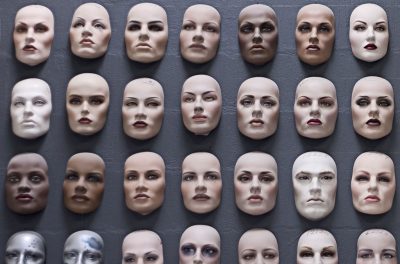
A new, interactive exhibit focused on implicit bias has arrived at the UConn Storrs campus. Created by the National Underground Railroad Freedom Center, the exhibit will be hosted at the Homer Babbidge Library through Feb. 28.
“Implicit bias is something that does impact our teacher education program, practicing teachers, and certainly students in classrooms today. So I felt like the Neag School was really well positioned to help bring in an exhibit that would work with our teacher candidates, our school and community partners, and the broader university,” says Mark Kohan, assistant clinical professor at the Neag School, who helped to coordinate UConn’s launch of the exhibit.
Admitting and identifying our own biases can be difficult and something we don’t know how to do. And yet two decades of scientific research has persuasively demonstrated that all of us harbor implicit bias even if we hold no explicit prejudice. These words open the description of the Implicit Bias exhibit, which invites participants the opportunity to attend to bias and other forms of discrimination, as well as to explore recent debates in the realm of implicit bias research.
An opening reception featuring Associate Professor Thomas Craemer of UConn’s Department of Public Policy will be held from 3-5 p.m. on Monday, Jan. 23, in the library’s staff lounge.
The exhibit is open to the public and is free of charge.
An Exhibit on Implicit Bias &
How It Affects Our Everyday Thoughts & BehaviorsJan. 16 – Feb. 28, 2017
M-TH 8 a.m. – 9 p.m. | F 8 a.m. – 5 p.m. | S/S 10 a.m. – 5 p.m.Homer D. Babbidge Library (Plaza Level Main Entrance)
UConn Storrs Campus
Exhibit co-sponsors include UConn’s Office for Diversity and Inclusion, Community Outreach, UConn Humanities Institute, Office of Public Engagement, UConn Law School, Human Rights Institute, Thomas J. Dodd Research Center, Neag School of Education, Higher Education and Student Affairs (HESA), School of Fine Arts, UConn Libraries, and the Connecticut Writing Project.
Learn more at thedoddcenter.uconn.edu/implicitbias.
A Message From the Equity and Social Justice Task Force
The Neag School of Education at the University of Connecticut has long committed itself to the values of diversity, collaboration, and informed intellectual inquiry, and for the past several years, has designated equity and social justice as a focal area in our academic vision.
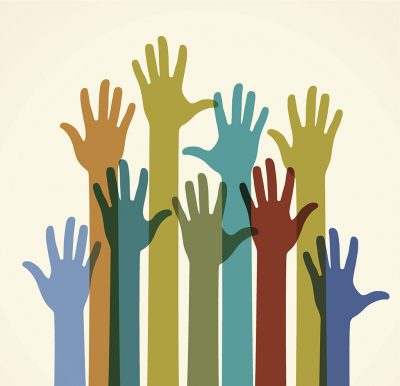
As members of the Equity and Social Justice Task Force, we believe that the new social and political context created by the presidential election requires not only that we reiterate these commitments, but also that we, the Equity and Social Justice Task Force, acknowledge and empathize with the many individuals and groups in our community who are experiencing a considerable amount of pain, fear, and concern for their safety. During the recent political campaign, women, members of the LGBTQ communities, individuals with disabilities, racial and ethnic minorities, immigrants, Muslims, refugees, and others were targeted with disparaging remarks. Given the recent spike in hate crimes across the country since the election (as chronicled by the Southern Poverty Law Center’s #reporthate), legitimate fear exists that such remarks will continue to translate into acts of harassment, incitement, and even violence.
In recognition of the current unrest in our country and on our campus, we, the Equity and Social Justice Task Force, would like to emphasize the following points:
1. The Neag School of Education is an inclusive, open, democratic, diverse, and caring community that values the diversity of its students, staff, and faculty.
2. We, the Equity and Social Justice Taskforce, do not condone and will actively oppose any effort to target, harass, intimidate or exclude individuals or groups on the basis of race, ethnicity, class, gender identity, sexual orientation, language, religion, national origin, disability, or immigration status.
3. We, the Equity and Social Justice Taskforce, believe that recognizing the inherent human rights and equal dignity of all people, listening to and striving to understand one another, and making a commitment to work together is the way to foster sustained, positive change in our society and world.
4. We, the Equity and Social Justice Taskforce, stand in solidarity with individuals and groups who advocate for empowering those who have been and continue to be systemically oppressed.
In summary, we, the Equity and Social Justice Taskforce, want to assure our students, staff, faculty, and partners that we will be vigilant in ensuring that our spaces are safe for all members of our community. The university’s policies and procedures with regard to bias, harassment, and intimidation are clear. Community members should should not hesitate to follow these procedures, and we encourage everyone to report any incidents directly to the Neag School Dean’s Office, their department, or other responsible members of the Neag School administration to ensure a comprehensive and timely response. We, the Equity and Social Justice Taskforce, also would like to remind community members that additional support and counseling are available from the university’s Counseling and Mental Health Services.
Resources:
Bias Incident Protocol
Counseling & Mental Health Services
Our dedication to our core values is not contingent upon political and/or social pendulums, but rather, is rooted in a lifelong pursuit of equity and justice for all. We, the Equity and Social Justice Taskforce, believe each individual and group reflects their values through their actions as well as through their inactions. Hence, we, the Equity and Social Justice Taskforce, will continue to work diligently alongside our social justice partners to deconstruct systems of oppression, empower groups that have been marginalized, and foster a deeper manifestation of diversity and inclusion in policy, and more importantly, in practice.
Equity and Social Justice Task Force Members
Dominique Battle-Lawson
Joseph N. Cooper
Anne Denerville
Madison Hooper
Elizabeth Howard
Thilagha Jagaiah
Mark Kohan
Eric Loken
Jennifer McGarry
Glenn Mitoma
Natalie Olinghouse
People’s Inauguration Emphasizes UConn’s Value of Community
The Daily Campus (Glenn Mitoma, director of the Dodd Center and Neag School faculty member, was interviewed about the importance of the event)
10 Questions With Husky Sport Alum Leading Volunteers in NYC
In our special recurring 10 Questions series, the Neag School is catching up with students, alumni, faculty, and others throughout the year to give you a glimpse into their Neag School experience and their current career, research, or community activities.

Brittany (Perotti) Agne ’09 (CLAS), ’11 MA, a former Husky Sport volunteer who earned a master’s degree with a concentration in sport management at the Neag School, today serves as director of children’s education programs at New York Cares, a New York City-based nonprofit focused on volunteer management whose staff plans 1,600 volunteer-led projects every month.
At what moment did you know that you wanted to work with New York Cares? It was honestly a series of fortuitous events that led me to New York Cares. I didn’t know much about the organization before I started working for it in 2011, but I did know by that time (thanks to Husky Sport) that I wanted to go into the nonprofit side of sports-based youth development work as an ultimate career goal. The position that was posted online was almost identical to my responsibilities with Husky Sport, including volunteer management and working with kids to promote positive and healthy behaviors through sports and nutrition programs. It felt like it was a position that was made for me.
What made you choose to work in the Children’s Education Programs department of New York Cares? When I first started, the Children’s Education Programs department didn’t exist. Instead, the two teams that comprise the department today were part of Community Programs and Education Programs. I was part of the Children’s Recreation team, housed under Community Programs, because the perception was that sports was an “additional” component to a child’s education.
Thanks in large part to movements within youth development (and, honestly, the Let’s Move campaign from [first lady] Michelle Obama), I think people have come around to the idea that physical activity is a key component to a child’s academic success. New York Cares made the formal change in November 2015 by creating the Children’s Education Programs department, and that allowed all of the people working on kids’ programs to be one team tackling the multifaceted issue of student achievement in New York City. Now, we have people working on arts, nutrition, and sports programs alongside people working on STEM, reading, and other literacy-based programs. It makes much more sense and allows us to have a deeper connection with our community partners.
What are the types of education programs offered to children through New York Cares? It ranges from your traditional academic programs, like homework help, reading and math support, and the like to opportunities such as coding, Lego Robotics, martial arts, yoga, photography, dance, field trips, and culinary arts. We try as much as possible to customize content to the kids with the understanding that each community and every student is unique in their needs and desires.
How have you been able to integrate your background in sport management into what you are doing now? There are a few ways, particularly around the corporate social responsibility piece of Dr. Laura Burton’s sport management class [at the Neag School]. We spent time [in that class] talking about how people can and should encourage their [employers] to take on a particular cause in their community. New York Cares is largely funded by companies looking to do just that, as this has become more of an expectation of employees, with millennials continuing to enter the workforce. … Other classes, like marketing, also feel transferrable to what we do.
Perhaps the clearest connection for me, though, is Dr. Jennie McGarry’s work with Husky Sport and the service learning class, as well as discussions around issues in sport that shed light on income and racial inequality. Seeing firsthand the Hartford Public Schools system in action allowed me to have some sense of the New York City Public Schools system, and it was great to have that classroom-based experience before coming into the NYC education world.
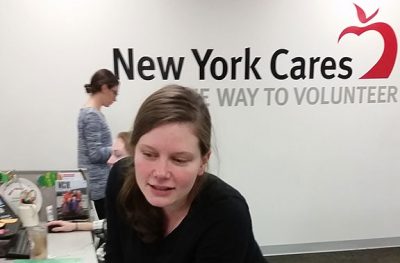
How is New York Cares making a difference for New York City youth? I feel the impact is twofold, and one may be more obvious than the other. First, we are providing supplemental instruction for kids who are below grade level in math and reading performance or whose school is underfunded and cannot provide recess/physical education as frequently as mandated by the city. For kids in shelters, it may provide a safe space for them to develop with peers, where there is structure and purpose to what they’re doing, even if it’s simply sitting down and reading a book with a volunteer for 30 minutes or going ice-skating for the first time in Bryant Park during the holidays. It teaches them how to navigate their fears and their city and provides some consistency in their schedules.
The second major impact is through providing the adult support for children, giving them specialized attention that they may not otherwise receive during school or out-of-school time. There have been multiple studies on positive youth development that touch upon this idea of a caring adult role model and building that relationship as being critical to the success of programs. It’s the idea behind Big Brothers Big Sisters and other national-level branches of volunteering.
But I would be remiss to ignore the impact that the kids have on the volunteers, and that is that kids see the world with a totally different perspective and make you realize what’s really important. I think they have a ton of lessons to teach our volunteers and can open their eyes to issues that people face in the city.
When did you discover your passion for volunteer work? I’ve spent much of my life doing community service and was a member of National Honor Society in high school, which had a community service requirement, and I absolutely love working with kids. So when I got to college, I spent a little time doing tutoring at an elementary school in Willimantic [Conn.] when it could fit into my schedule.
In my junior year, I heard about Husky Sport and was curious about getting involved. It didn’t fit into my schedule until senior year, but that first semester of service learning was amazing. At that point, I was hooked on working in the nonprofit world and stayed at UConn to do my master’s program in sport management as a graduate assistant for Husky Sport. I especially loved that the focus was on the sociological aspect of sport, not just on how to make it from a business perspective, and got you thinking about the power companies have to affect change in their communities.
“We value every hour people give of their time, and if it’s just once a year that people can volunteer for one hour, that’s still meaningful. You still have the opportunity to make a connection with someone whom you may never have had the chance to meet.”
What would like the public to know about New York Cares as a whole? New York Cares is so much more than our Coat Drive (which many people know us for, if they’ve heard of us) and Winter Wishes programs. Yes, these are critical services, but if you’re looking for a way to truly know your city — or even if you’re just visiting and want to get some real New York experiences — volunteering is an easy way to do it.
We started (almost) 30 years ago when a group of friends came together and tried to find ways to volunteer, but struggled due to the lack of flexibility that people found when looking to get involved. Once people create an account with us, they can quickly see how we try to adapt our model to their busy schedules. Orientations are scheduled throughout the city at all times of day, and are also available online. Projects range from working in food pantries and senior centers, to animal shelters, parks, gardens, shelters, and schools. We value every hour people give of their time, and if it’s just once a year that people can volunteer for one hour, that’s still meaningful. You still have the opportunity to make a connection with someone whom you may never have had the chance to meet.
We’ve had people from all over the world come to us because they’re in New York for a week and want to see what life is like for people throughout the city, so it’s not limited to residents of the city if you want to get involved. We engage companies in customized service opportunities and are an integral part of disaster response, so there are a multitude of options for anyone looking to volunteer. We run more than 1,000 opportunities each month and engage more than 64,000 volunteers each year in service.
What have been some of the most rewarding moments at your job? Any time I am able to get to a program to spend time with the kids and volunteers is a great reminder of the significance of our work. We hear things like ‘This is the best day ever!’ from kids when we take them on trips or have volunteers in their classroom. Even though there can be days that are difficult, remembering that there is a person on the other side who is being impacted by your decisions puts it all into perspective. And the thank-you notes that the kids send to us are still hanging up in my office. They just have this enthusiasm for life and meeting new people that makes it all worth it.
In my work, I get to see the best side of New Yorkers, who are stereotyped as cynical and uncaring, but it’s really not the case. People are busy, stressed, and on the go 24/7 — that’s true — but they also find ways to get involved with their communities as a way to get to know their neighbors better or because they feel it’s the right thing to do. The motivation of kindness drives people to give even in the most difficult situations. It bridges the gap in socioeconomic status and allows the recipients of service to be empowered to also teach the volunteers.
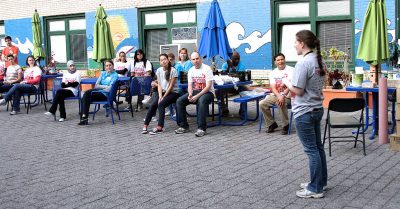
What are some challenging moments you’ve had while working at New York Cares? The biggest challenge had to be Superstorm Sandy. Our office is in the Financial District, which had storm surges (we are right near Battery Park and the Battery Park Tunnel, which was completely underwater), so we were doing work remotely across the tri-state area. It was a true test of our systems in terms of keeping in touch with co-workers, as well as volunteers and partners.
A week after the storm hit, we were able to get back into our office because the subways finally reopened. We had 16-18 hour days from Oct. 29, 2012, until December of that year. Partners would call us at all hours, and we would post projects for people to volunteer at food distribution sites, as well as canvassing housing complexes to ensure that residents were safe and able to get their medicines, especially the elderly and those unable to take stairs.
Four years later, I can still remember it like it was yesterday, but it is a powerful reminder of what people deal with in the wake of disaster. For people in the flood zones, they’re still working to get back what was lost.
What were some of your favorite moments at UConn? As an undergrad, I worked for The Daily Campus as a sports beat writer and covered the women’s basketball teams in 2007-08 and 2008-09. We got to travel to the women’s tournaments, and I got the chance to see the best women’s basketball program courtside. That experience also taught me that I didn’t want to pursue a career in sports journalism, which was my original plan when I entered college, but it gave me a greater appreciation for the work that journalists do and the value of having trained journalists in a world of blogs and social media. I also loved Oozeball and the concerts that SUBOG put together.
Of course, my time with Husky Sport is also high up there with my favorite memories, particularly spending time in Ms. Vargas’ bilingual 3rd-grade class at Wish [school in Hartford], reading with her students and seeing how excited they were for nonfiction work, and Ms. Ziplow’s 6th-grade class, discussing current events.
What are your favorite things about New York City? There is such a diverse group of people that you interact with on a daily basis, regardless of where you go in the city, so there are times when you feel like you’ve stepped into another country. It gives a real sense of appreciation for the cultures of the people in that particular neighborhood. There’s also always something to do, and if you’re creative enough, you can find many things that are free to the public. With work, I get the chance to explore places a bit more with field trips and projects throughout the city.
Learn more about New York Cares at newyorkcares.org. Read other installments of the 10 Questions series here.
